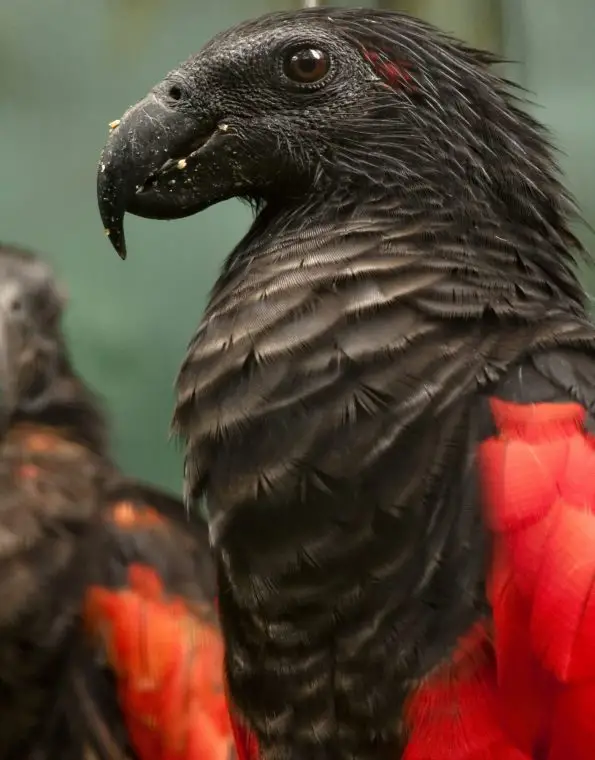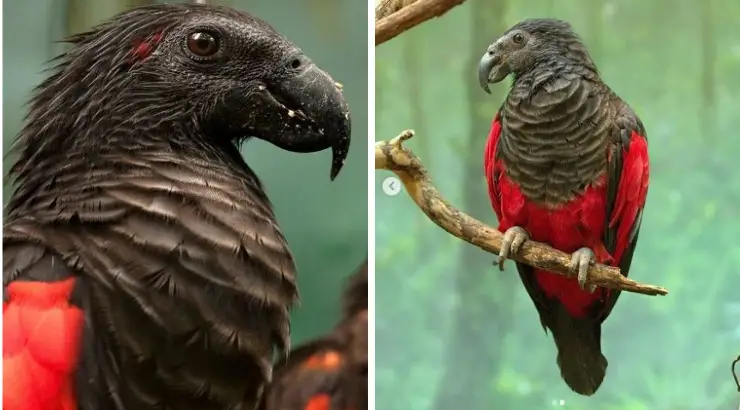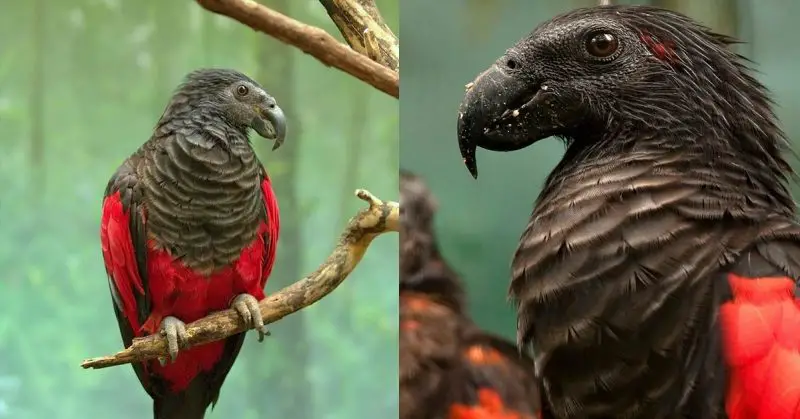Parrots are supposed to be cute (and sometimes annoying) with adorable colours and perky beaks. Well, when it comes to the animal kingdom, there are always exceptions to the “cute rule“. Have you ever seen a parrot that is stunningly beautiful and terrifying at the same time?
No? Well, meet the Dracula parrot, a striking exception to the parrot species “cute rule“.

What makes this beautiful bird unique is its stunning feathers and haunting vulture-like face. Although its official name is Pesquet’s parrot (Psittrichas fulgidus), the bird is commonly called the Vulturine parrot or Dracula parrot. [1]
One of the reasons why it is referred to as the Dracula parrot is its rasping growl in flight and piercing scream at night that never fail to send shivers down anyone’s spine. Then there’s the colored plumage that looks disturbingly like Dracula’s black attire and red silk cloak.

The cloud forests in the foothills and the lower mountains of New Guinea host this fantastic species. Sadly, the Pesquet’s parrot is now endangered owing to the activities of poachers who hunt it for its beautiful red feathers. These feathers are traditionally used to make ceremonial dresses.
The birds are also killed for meat and captured for the cage bird trade.
According to Red List:
“Hunting for feathers has increased with population growth. Current rates of decline due to hunting are uncertain but could be relatively minor, and the species appears secure in large areas of suitable habitat in central and western mainland Papua New Guinea, much of which occurs in rugged terrain in areas with a low human population density.”
The average Pesquet’s parrot measures around 20 inches (49 cm) and weighs between 600–800 g. Its raven-black feather is complemented by a short black tail, grey scalloped feathers, dark reddish-brown eyes, under-wing coverts, and brown-black breasts.
The eyes, beak, and forepart of its head have no feathers, and the neck is bristled. Male and female are almost identical, with the only distinctive feature being a red patch behind the eyes of males. Pesquet’s parrots travel in small groups and glide more often than other parrots.

Unlike most parrots that climb from branch to branch, the Pesquet’s parrot exclusively feeds on mangoes and a few species of figs. It is one of three parrots that do not have feathers on their faces, and scientist believes that the absence of feathers around its beak and eyes is the parrot’s way of preventing its face from matting with the sticky fruit pulp it feeds on.
Australian parrot expert, Matt Cameron thinks that losing its feathers is a perfect solution to the parrot’s syrupy diet.
“If avoiding soiled and matted head feathers is a significant advantage to individuals, it is surprising that bald-headedness is not more widespread among the other fruit-eating parrots.” [2]
The true parrot superfamily
The Dracula parrot is a member of the Psittrichasiidae family, which has two subfamilies: Psittrichasinae, of which Pesquet’s parrot is the only genus and the vasa parrots, which are endemic to islands in the western Indian Ocean and Madagascar.
The Psittrichasiidae family, of which the Dracula parrot belongs, is just one of the three families that make up the superfamily Psittaco idea. Other members are:
- The Psittaculidae family, which is split into five subfamilies: Psittaculinae, Agapornithinae, Platycercinae, Loriinae, and Psittacellinae. This family has hundreds of members, which include budgerigars, fig parties, and lorikeets.
- The Psittacinae family, which includes 11 known species, with the most popular being the African grey parrot. They are mostly found in Madagascar, Sub-Saharan Africa, and the Arabian Peninsula. [3]
References
- “PESQUET’S PARROT.” Wcs Papua New Guinea. Admin. Accessed February 6, 2020.
- ” The Dracula parrot is as intimidating AF.” Australian Geographic. Bec Crew. December 9, 2019.
- “Parrot Facts: Habits, Habitat & Species.” Live Science. Alina Bradford. July 24, 2014.

